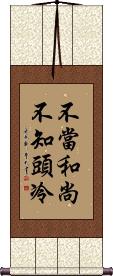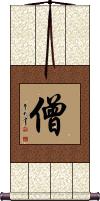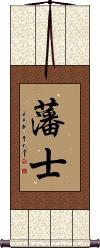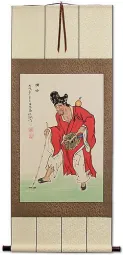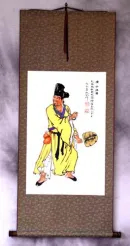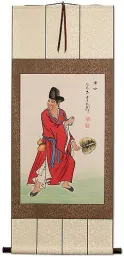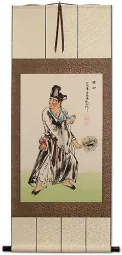Many custom options...
And formats...

Monk in Chinese / Japanese...
Buy a Monk calligraphy wall scroll here!
Personalize your custom “Monk” project by clicking the button next to your favorite “Monk” title below...
To Know Hardship, One Must Experience It
不當和尚不知頭冷 is a Chinese proverb that literally translates as: [One who has] not been a monk [does] not know [the feeling of a] cold head.
I need to explain that a Chinese Buddhist monk always has a shaved head, and thus a cold head in winter.
Figuratively, this means: One cannot know the true meaning of hardship until one has experienced it oneself.
This is an idiom in Chinese, so the figurative meaning is what people perceive when they hear or read this phrase. Just as in English, when someone says, "The grass is always greener," one will think about the idea of jealousy, rather than the quality of one’s lawn.
Buddhist Monk
僧侶/僧侶 is a Japanese title for a Buddhist monk.
The first Kanji means Buddhist priest or monk by itself.
The second Kanji means follower or companion.
![]() Note, if you order this from the Japanese master calligrapher, the first character will look a bit more like the Kanji shown to the right than the Kanji shown above. Let us know if you have a preference, as both versions are technically-correct in both Chinese and Japanese.
Note, if you order this from the Japanese master calligrapher, the first character will look a bit more like the Kanji shown to the right than the Kanji shown above. Let us know if you have a preference, as both versions are technically-correct in both Chinese and Japanese.
If you have not been a monk, how can you know what it is like to be a vegetarian?
Only by experiencing hardship will allow you understand the plight of others
不當和尚不知齋戒苦 literally translates as:
[One who has] not been a monk [does not] know the suffering of [being on a] vegetarian diet.
This is a bit like the “walk a mile in another man's shoes” saying. Basically, it's about you cannot fully understand the plight of others until you experience it yourself.
Sangha / Order of Monks
僧 is the single-character or short form of Sangha, the Buddhist idea of community or order (of monks, nuns, or followers of the Buddha).
Alone, this character can simply mean “monk” (Just means monk in Japanese).
![]()
![]() Note that when writing this as Kanji, Japanese will tend to write this in the form shown to the right. If you select our Japanese master calligrapher, please expect this special Kanji form.
Note that when writing this as Kanji, Japanese will tend to write this in the form shown to the right. If you select our Japanese master calligrapher, please expect this special Kanji form.
Warrior Monk / Soldier Priest
This in-stock artwork might be what you are looking for, and ships right away...
Ji Gong
The Mad Monk of China
Wall Scroll
Discounted Blemished
Gallery Price: $63.00
Your Price: $35.00
These search terms might be related to Monk:
Holy Man / Saint
Warrior Monk / Soldier Priest
Not the results for monk that you were looking for?
Below are some entries from our dictionary that may match your monk search...
| Characters If shown, 2nd row is Simp. Chinese |
Pronunciation Romanization |
Simple Dictionary Definition |
僧 see styles |
sēng seng1 seng sou / so そう |
More info & calligraphy: Sangha / Order of Monks(1) monk; priest; (2) (abbreviation) (See 僧伽・そうぎゃ) sangha (the Buddhist community); (surname) Sou 僧伽 saṅgha, an assembly, collection, company, society. The corporate assembly of at least three (formerly four) monks under a chairman, empowered to hear confession, grant absolution, and ordain. The church or monastic order, the third member of the triratna. The term 僧 used alone has come to mean a monk, or monks in general. Also僧佉, 僧加, 僧企耶.; A fully ordained monk, i.e. a bhikṣu as contrasted with the śramaņa. |
寂 see styles |
jì ji4 chi jaku; seki じゃく; せき |
More info & calligraphy: Silent / Solitary(1) (entering into) nirvana; (suffix noun) (2) (used after a date to indicate the death of a monk at that time) died; (adj-t,adv-to) (3) (usu. せき) silent; tranquil; (female given name) Yoshika praśama; vivikta; śānti. Still, silent, quiet, solitary, calm, tranquil, nirvāṇa. |
聖 圣 see styles |
shèng sheng4 sheng hijiri ひじり |
More info & calligraphy: The Saint(1) highly virtuous monk; (2) (honorific or respectful language) monk; (3) Buddhist solitary; (4) (See 高野聖・1) Buddhist missionary; (5) saint (i.e. a virtuous person); (6) (archaism) (honorific or respectful language) emperor; (7) (in form 〜の聖) master; expert; (female given name) Mina ārya; sādhu; a sage; wise and good; upright, or correct in all his character; sacred, holy, saintly. |
僧伽 see styles |
sēng qié seng1 qie2 seng ch`ieh seng chieh sougya / sogya そうぎゃ |
More info & calligraphy: Sanghasangha (the Buddhist community) (san: samgha) (Skt. saṃgha) |
僧侶 僧侣 see styles |
sēng lǚ seng1 lu:3 seng lü souryo / soryo そうりょ |
More info & calligraphy: Buddhist Monk{Buddh} priest; monk; bonze Monastic companions, or company. |
十戒 see styles |
shí jiè shi2 jie4 shih chieh jukkai じゅっかい |
More info & calligraphy: Ten Commandments(1) (Buddhist term) the 10 precepts; (2) Ten Commandments; Decalogue; Decalog; (surname) Jukkai Śikṣāpada. The ten prohibitions (in Pāli form) consist of five commandments for the layman: (1) not to destroy life 不殺生 pāṇātipātāveramaṇi; (2) not to steal 不倫盜 adinnādānāver; (3) not to commit adultery 不婬慾 abrahmacaryaver.; (4) not to lie 不妄語musāvādāver.; (5) not to take intoxicating liquor 不飮酒 suramereyya-majjapamādaṭṭhānāver. Eight special commandments for laymen consist of the preceding five plus: (6) not to eat food out of regulated hours 不非時食 vikāla-bhojanāver.; (7) not to use garlands or perfumes 不著華鬘好香塗身 mālā- gandha-vilepana-dhāraṇa-maṇḍana-vibhūṣanaṭṭhānā; (8) not to sleep on high or broad beds (chastity) 不坐高廣大牀 uccāsayanā-mahāsayanā. The ten commandments for the monk are the preceding eight plus: (9) not to take part in singing, dancing, musical or theatrical performances, not to see or listen to such 不歌舞倡伎不往觀聽 nacca-gīta-vādita-visūkadassanāver.; (10) to refrain from acquiring uncoined or coined gold, or silver, or jewels 不得捉錢金銀寶物 jātarūpa-rajata-paṭīggahaṇāver. Under the Māhayāna these ten commands for the monk were changed, to accord with the new environment of the monk, to the following: not to kill, not to steal, to avoid all unchastity, not to lie, not to slander, not to insult, not to chatter, not to covet, not to give way to anger, to harbour no scepticism. |
合十 see styles |
hé shí he2 shi2 ho shih gōjū |
More info & calligraphy: Namaste - Greeting合爪; 合掌 To bring the ten fingers or two palms together; a monk's salutation. |
大師 大师 see styles |
dà shī da4 shi1 ta shih daishi だいし |
More info & calligraphy: Grand Master / Great Teacher(honorific or respectful language) {Buddh} great teacher (i.e. a buddha, bodhisattva or high monk, esp. Kobo Daishi); (place-name) Daishi Great teacher, or leader, one of the ten titles of a Buddha. |
天皇 see styles |
tiān huáng tian1 huang2 t`ien huang tien huang tennou / tenno てんのう |
More info & calligraphy: Emperor of JapanEmperor of Japan; (place-name) Tennou Deva-king; the Tang monk 道悟 Daowu of the 天皇 Tianhuang monastery at 荊州 Jingzhou. |
師檀 师檀 see styles |
shī tán shi1 tan2 shih t`an shih tan shidan |
More info & calligraphy: Shidan |
恩度 see styles |
ēn dù en1 du4 en tu ondo |
More info & calligraphy: Endu |
慧能 see styles |
huì néng hui4 neng2 hui neng enou / eno えのう |
More info & calligraphy: Huineng(person) Huineng (638-713) The power of wisdom. Huineng, name of a noted monk, sixth patriarch of the Intuitional or Meditation sect; died 713. |
老師 老师 see styles |
lǎo shī lao3 shi1 lao shih roushi / roshi ろうし |
More info & calligraphy: Teacher / Master / Old Sage(1) old master; old teacher; (2) old monk; aged priest old master |
般若 see styles |
bō rě bo1 re3 po je hannya はんにゃ |
More info & calligraphy: Great Wisdom(1) {Buddh} prajna (wisdom required to attain enlightenment); (2) {noh} (See 般若面・1) hannya; mask of a grinning, horned demoness (represents a woman's rage and jealousy); (3) (abbreviation) (See 般若面・2) dreadful face (esp. of a woman driven mad by jealousy); terrifying facial expression; (surname) Hanniya (般賴若) Prajñā is also the name of a monk from Kabul, A.D. 810, styled 三藏法師; tr. four works and author of an alphabet.; prajñā, 'to know, understand'; 'Wisdom. ' M. W. Intp. 慧 wisdom; 智慧 understanding, or wisdom; 明 clear, intelligent, the sixth pāramitā. The Prajñā-pāramitā Sutra describes it as supreme, highest, incomparable, unequalled, unsurpassed. It is spoken of as the principal means, by its enlightenment, of attaining to nirvana, through its revelation of the unreality of all things. Other forms 般羅若; 般諄若; 鉢若; 鉢剌若; 鉢羅枳孃; 鉢腎禳; 波若, 波賴若; 波羅孃; 班若. |
菩薩 菩萨 see styles |
pú sà pu2 sa4 p`u sa pu sa bosatsu(p); bosachi(ok) ぼさつ(P); ぼさち(ok) |
More info & calligraphy: Bodhisattva(n,n-suf) (1) {Buddh} bodhisattva; one who has reached enlightenment but vows to save all beings before becoming a buddha; (n,n-suf) (2) High Monk (title bestowed by the imperial court); (n,n-suf) (3) (See 本地垂迹説) title bestowed to Shinto kami in manifestation theory; (surname) Mizoro bodhisattva, cf. 菩提薩埵. While the idea is not foreign to Hīnayāna, its extension of meaning is one of the chief marks of Mahāyāna. 'The Bodhisattva is indeed the characteristic feature of the Mahāyāna.' Keith. According to Mahāyāna the Hinayanists, i.e. the śrāvaka and pratyekabuddha, seek their own salvation, while the bodhisattva's aim is the salvation of others and of all. The earlier intp. of bodhisattva was 大道心衆生 all beings with mind for the truth; later it became 大覺有情 conscious beings of or for the great intelligence, or enlightenment. It is also intp. in terms of leadership, heroism, etc. In general it is a Mahayanist seeking Buddhahood, but seeking it altruistically; whether monk or layman, he seeks enlightenment to enlighten others, and he will sacrifice himself to save others; he is devoid of egoism and devoted to helping others. All conscious beings having the Buddha-nature are natural bodhisattvas, but require to undergo development. The mahāsattva is sufficiently advanced to become a Buddha and enter nirvāṇa, but according to his vow he remains in the realm of incarnation to save all conscious beings. A monk should enter on the arduous course of discipline which leads to Bodhisattvahood and Buddhahood. |
道士 see styles |
dào shì dao4 shi4 tao shih doushi / doshi どうし |
More info & calligraphy: Taoist / Daoist(1) Taoist; (2) person of high morals; (3) Buddhist monk; (4) immortal mountain wizard; Taoist immortal; (personal name) Michishi A Taoist (hermit), also applied to Buddhists, and to Śākyamuni. |
雲水 云水 see styles |
yún shuǐ yun2 shui3 yün shui unsui; kumomizu うんすい; くもみず |
More info & calligraphy: Unsui雲兄水弟; 雲衲; 雲納 Homeless or roaming monks. |
無門関 see styles |
mumonkan むもんかん |
More info & calligraphy: Mumonkan / The Gateless Gate |
獅子座 狮子座 see styles |
shī zi zuò shi1 zi5 zuo4 shih tzu tso shishi za ししざ |
More info & calligraphy: Leo Zodiac Symbol / Sign(1) {astron} Leo (constellation); the Lion; (2) {Buddh} (See 獅子の座) Buddha's seat; seat of a high monk lion's seat |
波羅末陀 波罗末陀 see styles |
bō luó mò tuó bo1 luo2 mo4 tuo2 po lo mo t`o po lo mo to haramada |
More info & calligraphy: Paramartha |
釋迦牟尼 释迦牟尼 see styles |
shì jiā móu ní shi4 jia1 mou2 ni2 shih chia mou ni Shakamuni |
More info & calligraphy: Shakyamuni / The Buddha釋迦文 (釋迦文尼); 釋伽文 Śākyamuni, the saint of the Śākya tribe. muni is saint, holy man, sage, ascetic monk; it is: intp. as 仁 benevolent, charitable, kind, also as 寂默 one who dwells in seclusion. After '500 or 550' previous incarnations, Śākyamuni finally attained to the state of Bodhisattva, was born in the Tuṣita heaven, and descended as a white elephant, through her right side, into the womb of the immaculate Māyā, the purest woman on earth; this was on the 8th day of the 4th month; next year on the 8th day of the 2nd month he was born from her right side painlessly as she stood under a tree in the Lumbinī garden. For the subsequent miraculous events v. Eitel. also the 神通遊戲經 (Lalitavistara), the 釋迦如來成道記, etc. Simpler statements say that he was born the son of Śuddhodana, of the kṣatriya caste, ruler of Kapilavastu, and Māyā his wife; that Māyā died seven days later, leaving him to be brought up by her sister Prājapati; that in due course he was married to Yaśodharā who bore him a son, Rāhula; that in search of truth he left home, became an ascetic, severely disciplined himself, and finally at 35 years of age, under a tree, realized that the way of release from the chain of rebirth and death lay not in asceticism but in moral purity; this he explained first in his four dogmas, v. 四諦 and eightfold noble way 八正道, later amplified and developed in many sermons. He founded his community on the basis of poverty, chastity, and insight or meditation, ad it became known as Buddhism, as he became known as Buddha, the enlightened. His death was probably in or near 487 B.C., a few years before that of Confucius in 479. The sacerdotal name of his family is Gautama, said to be the original name of the whole clan, Śākya being that of his branch, v. 瞿, 喬.; his personal name was Siddhārtha, or Sarvārthasiddha, v. 悉. |
俗 see styles |
sú su2 su zoku(p); shoku(ok) ぞく(P); しょく(ok) |
custom; convention; popular; common; coarse; vulgar; secular (1) layman (esp. as opposed to a Buddhist monk); laity; man of the world; the world; (2) local manners; modern customs; (adj-na,adj-no) (3) common; popular; (adj-na,adj-no) (4) (ant: 雅・が・1) vulgar; low common, ordinary, usual, vulgar. |
坊 see styles |
fáng fang2 fang bou; bon / bo; bon ぼう; ぼん |
workshop; mill; Taiwan pr. [fang1] (1) bonze; monk; (2) (ぼう only) monk's dwelling; (3) boy; son; sonny; (4) (ぼう only) (used by male children) I; me; (suffix) (5) (ぼう only) (familiar language) (after name; familiar form of address) little; (suffix) (6) (ぼう only) (often preceded by ん) person who is ...; (surname) Machi A place, locality; a temple, place of assembly, etc. |
墨 see styles |
mò mo4 mo boku ぼく |
ink stick; China ink; CL:塊|块[kuai4]; corporal punishment consisting of tattooing characters on the victim's forehead (1) (abbreviation) (See 墨西哥・メキシコ) Mexico; (2) (rare) (See 墨家) Mohism; (3) (archaism) (See 墨・1) ink; (4) (abbreviation) (hist) (See 墨刑) tattooing (as a form of punishment in ancient China); (personal name) Boku Ink; black; dyed black, e.g. 墨衣 black clothes, at one time said to have been the garb of the monk to distinguish him from the ordinary people who wore white. |
師 师 see styles |
shī shi1 shih shi し |
teacher; master; expert; model; army division; (old) troops; to dispatch troops (1) teacher; master; mentor; (n,suf) (2) religious leader; (suffix) (3) specialist; (4) (hist) five-battalion brigade comprising 2500 men (Zhou dynasty Chinese army); (surname) Morosaki A host, army; a leader, preceptor, teacher, model; tr. of upādhyāya, an 'under-teacher', generally intp. as a Buddhist monk. |
度 see styles |
duó duo2 to do ど |
to estimate; Taiwan pr. [duo4] (n,n-suf) (1) degree (angle, temperature, scale, etc.); (counter) (2) counter for occurrences; (n,n-suf) (3) strength (of glasses); glasses prescription; (n,n-suf) (4) alcohol content (percentage); alcohol by volume; (5) (See 度を過ごす) extent; degree; limit; (6) (See 度を失う) presence of mind; composure; (given name) Wataru pāramitā, 波羅蜜; intp. by 渡 to ferry over; to save. The mortal life of reincarnations is the sea; nirvana is the other shore; v. pāramitā, 波. Also, to leave the world as a monk or nun, such is a 度得 or 度者. |
戒 see styles |
jiè jie4 chieh kai; ingoto(ok) かい; いんごと(ok) |
to guard against; to exhort; to admonish or warn; to give up or stop doing something; Buddhist monastic discipline; ring (for a finger) (1) (かい only) {Buddh} admonition; commandment; (2) sila (precept) śīla, 尸羅. Precept, command, prohibition, discipline, rule; morality. It is applied to the five, eight, ten, 250, and other commandments. The five are: (1) not to kill; (2 ) not to steal; (3) not to commit adultery; (4) not to speak falsely; (5) not to drink wine. These are the commands for lay disciples; those who observe them will be reborn in the human realm. The Sarvāstivādins did not sanction the observance of a limited selection from them as did the 成實宗 Satyasiddhi school. Each of the five precepts has five guardian spirits, in all twenty-five, 五戒二十五神. The eight for lay disciples are the above five together with Nos. 7, 8, and 9 of the following; the ten commands for the ordained, monks and nuns, are the above five with the following: (6) not to use adornments of flowers, nor perfumes; (7) not to perform as an actor, juggler, acrobat, or go to watch and hear them; (8) not to sit on elevated, broad, and large divans (or beds); (9) not to eat except in regulation hours; (10) not to possess money, gold or silver, or precious things. The 具足戒full commands for a monk number 250, those for a nun are 348, commonly called 500. Śīla is also the first of the 五分法身, i.e. a condition above all moral error. The Sutra of Brahma's Net has the following after the first five: (6) not to speak of the sins of those in orders; (7) not to vaunt self and depreciate others; (8) not to be avaricious; (9) not to be angry; (10) not to slander the triratna. |
戲 戏 see styles |
xì xi4 hsi ke |
trick; drama; play; show; CL:齣|出[chu1],場|场[chang3],臺|台[tai2] khelā, krīḍā. Play, sport, take one's pleasure; theatricals, which are forbidden to a monk or nun. |
房 see styles |
fáng fang2 fang bou / bo ぼう |
house; room; CL:間|间[jian1]; branch of an extended family; classifier for family members (or concubines) (1) chamber; room; cell (prison); atrium; (2) (See 坊・2) home of a monk; monk; (3) {astron} (See 二十八宿,蒼竜・そうりょう・3) Chinese "room" constellation (one of the 28 mansions); (surname) Bou House, room. The rooms for monks and nuns in a monastery or nunnery. |
缽 钵 see styles |
bō bo1 po hatsu |
small earthenware plate or basin; a monk's alms bowl; Sanskrit paatra begging bowl |
Click here for more monk results from our dictionary
The following table may be helpful for those studying Chinese or Japanese...
| Title | Characters | Romaji (Romanized Japanese) | Various forms of Romanized Chinese | |
| To Know Hardship, One Must Experience It | 不當和尚不知頭冷 不当和尚不知头冷 | bù dāng hé shàng bù zhī tóu lěng bu4 dang1 he2 shang4 bu4 zhi1 tou2 leng3 bu dang he shang bu zhi tou leng | pu tang ho shang pu chih t`ou leng pu tang ho shang pu chih tou leng |
|
| Buddhist Monk | 僧侶 / 僧侶 僧侶 | sou ryo / souryo / so ryo | ||
| If you have not been a monk, how can you know what it is like to be a vegetarian? | 不當和尚不知齋戒苦 不当和尚不知斋戒苦 | bù dāng hé shang bù zhī zhāi jiè kǔ bu4 dang1 he2 shang bu4 zhi1 zhai1 jie4 ku3 bu dang he shang bu zhi zhai jie ku | pu tang ho shang pu chih chai chieh k`u pu tang ho shang pu chih chai chieh ku |
|
| Sangha Order of Monks | 僧 | sou / so | sēng / seng1 / seng | |
| Warrior Monk Soldier Priest | 藩士 | sou hei / souhei / so hei | sēng bīng seng1 bing1 seng bing sengbing | seng ping sengping |
| In some entries above you will see that characters have different versions above and below a line. In these cases, the characters above the line are Traditional Chinese, while the ones below are Simplified Chinese. | ||||
Successful Chinese Character and Japanese Kanji calligraphy searches within the last few hours...
